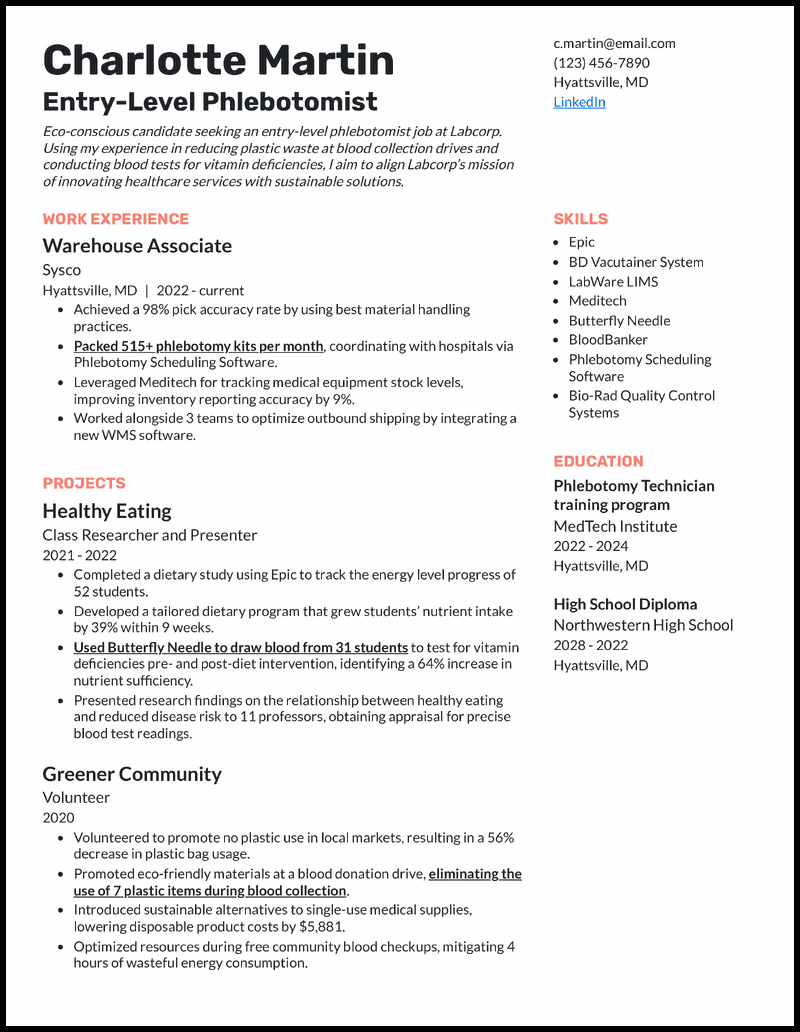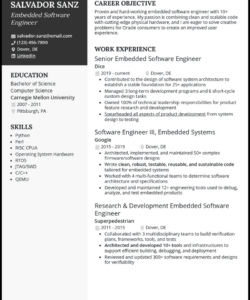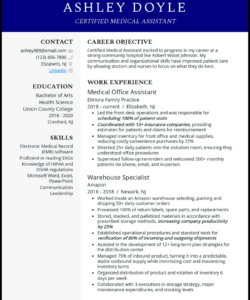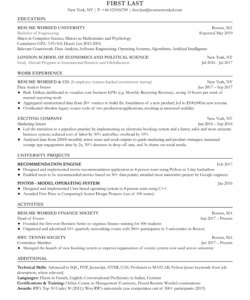Embarking on a career as a phlebotomist is an exciting step, offering a vital role in healthcare and direct patient interaction. You’ve completed your training, perhaps earned your certification, and now you’re eager to land that first job. The challenge often lies in presenting your skills and enthusiasm when you don’t have extensive work experience in the field yet.
This is where a compelling resume becomes your best advocate. It’s your chance to make a strong first impression and demonstrate your readiness for the role. Crafting a resume that highlights your relevant education, practical training, and soft skills is crucial for entry-level positions, and having a well-structured entry level phlebotomist resume template can truly guide you.
Crafting Your First Impression: Essential Sections for Your Resume
When you’re just starting out, your resume isn’t just a list of past jobs; it’s a forward-looking document that showcases your potential, dedication, and readiness to learn and contribute. Recruiters understand that entry-level candidates won’t have years of experience, so they’re looking for different cues. This section is where you demonstrate that you’ve got the foundational knowledge and the right attitude, making your entry level phlebotomist resume template a powerful tool to organize this information effectively.

Contact Information: Easy to Reach
This might seem obvious, but it’s surprising how often vital contact details are missed or hard to find. Make sure your name, phone number, professional email address, and optionally a link to your LinkedIn profile (if it’s professional and up-to-date) are prominently displayed at the top. This ensures that when a hiring manager is impressed, they can easily get in touch.
Objective or Summary: Your First Pitch
For entry-level candidates, an objective statement is often more effective than a summary. A summary typically highlights years of experience and achievements, which you might not have yet. An objective, on the other hand, clearly states your career goals and what you aspire to bring to the role. Be specific and enthusiastic. For example, “Highly motivated and recently certified phlebotomist seeking to apply strong venipuncture skills and compassionate patient care in a fast-paced clinical setting at [Hospital/Clinic Name].”
Your educational background and certifications are paramount for an entry-level phlebotomist. This is where you prove you have the necessary formal training. Be sure to list:
* The name of your phlebotomy program and the institution you attended.
* Your graduation date or expected completion date.
* Any relevant coursework that directly applies to phlebotomy, such as anatomy and physiology, medical terminology, infection control, or specific venipuncture techniques.
* All relevant certifications, such as Certified Phlebotomy Technician (CPT) from organizations like the National Healthcareer Association (NHA) or the American Society for Clinical Pathology (ASCP). Include the certification name, the issuing body, and the date obtained.
Even without paid work experience, your clinical rotations, externships, or practical training are invaluable. Treat these experiences as if they were jobs. Describe your duties using action verbs and quantify your experience where possible. For instance, instead of “did blood draws,” write “Performed venipuncture on an average of 20-30 patients daily, including diverse age groups and challenging veins.” Mention the types of settings you worked in (e.g., outpatient clinic, hospital lab) and any specific equipment or systems you became proficient with. Highlight your patient interaction skills, safety protocols followed, and adherence to professional standards.
Finally, dedicate a section to your skills. This should include both your hard skills (technical abilities specific to phlebotomy) and soft skills (personal attributes that make you a good employee). Hard skills might include venipuncture techniques (butterfly, syringe, evacuated tube systems), specimen processing, centrifuge operation, and electronic health record (EHR) navigation. Soft skills are equally important and include communication, empathy, attention to detail, teamwork, problem-solving, and time management.
Making Your Entry-Level Resume Shine: Tips and Tricks
Beyond simply listing your credentials, there are several ways to make your entry-level phlebotomy resume truly stand out from the crowd. Recruiters are looking for candidates who not only possess the basic qualifications but also demonstrate enthusiasm, a strong work ethic, and a genuine interest in patient care. This section delves into refining your content to capture that essential attention.
One of the most impactful things you can do is quantify your achievements, even in a training setting. Instead of just saying you performed blood draws, elaborate on the scale and context. How many draws did you complete during your clinical rotation? What types of patients did you work with (pediatric, geriatric, difficult draws)? Did you maintain a specific success rate? Numbers provide concrete evidence of your capabilities and demonstrate a results-oriented mindset. Always use strong action verbs like “performed,” “managed,” “assisted,” “maintained,” “processed,” and “documented” to describe your responsibilities and accomplishments.
Highlighting your soft skills is incredibly important, especially in a patient-facing role like phlebotomy. While technical skills are a given, your ability to interact with patients, manage stress, and work effectively in a team is paramount. Think about instances during your training where you demonstrated these qualities. Did you calm an anxious patient? Did you effectively communicate complex procedures in simple terms? Did you handle a challenging situation with grace and professionalism?
Consider including a dedicated “Skills” section, if you haven’t already, listing relevant abilities. Some key soft skills to emphasize for a phlebotomist include:
* Compassion and Empathy
* Exceptional Communication (verbal and non-verbal)
* Attention to Detail and Accuracy
* Patience and Calm Under Pressure
* Teamwork and Collaboration
* Problem-Solving Abilities
Before you send your resume anywhere, proofread it meticulously. Even small typos or grammatical errors can leave a negative impression. Ask a trusted friend, family member, or career counselor to review it for clarity, conciseness, and accuracy. Also, remember to tailor your resume for each specific job application. While an entry level phlebotomist resume template provides a great starting point, always customize it to align with the keywords and requirements mentioned in the job description. This shows the hiring manager that you’ve put thought into your application and are genuinely interested in *their* specific role.
Finally, always consider accompanying your resume with a well-crafted cover letter. This is your opportunity to expand on your motivation, express your passion for phlebotomy, and explain why you believe you’d be a great fit for that particular organization. It allows you to tell a brief story that your resume, by its nature, cannot.
Your journey into phlebotomy is just beginning, and a well-prepared resume is your most valuable asset in securing that first crucial role. By focusing on your relevant training, showcasing your practical experience, and highlighting both your technical and interpersonal skills, you can create a compelling document that stands out to hiring managers.
Remember, every experienced phlebotomist started exactly where you are now. With a thoughtfully constructed resume that effectively communicates your potential and passion for the profession, you are well on your way to making a significant contribution to patient care and establishing a rewarding career in healthcare.


